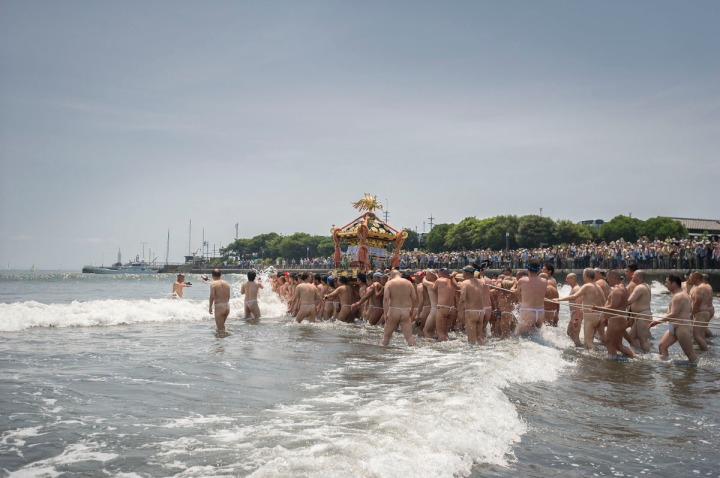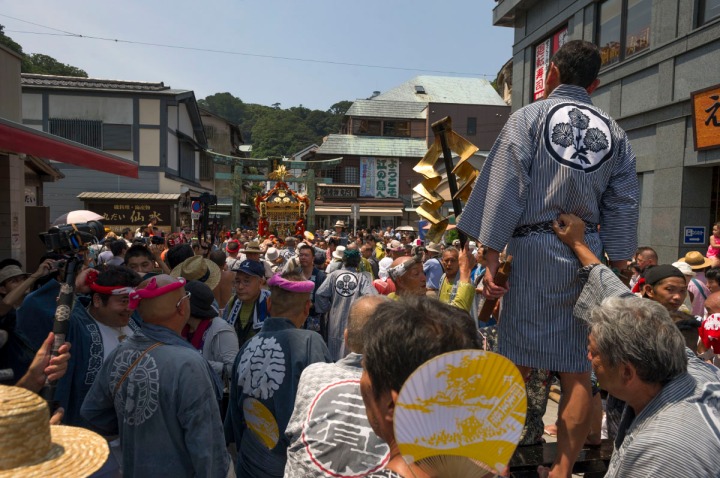Enoshima Festival – Into the Ocean
The end of the Enoshima Shrine festival that I have been blogging about this week, comes when the Omikoshi is carried down into the ocean by lots of nearly naked men. Usually the omikoshi is taken as deeply as possible into the ocean but on this day there was a typhoon on its way to Japan so the waves were much fiercer than usual: every couple of minutes the level of the ocean would suddenly rise a meter or so, when the waves came through, making it far too dangerous to actually take the omikoshi into deeper water. It looked like the men carrying it were having great fun though, even in the not very deep water!
Enoshima Shrine Festival – Through the Town
If you have ever been to Enoshima you know that the main street running through the little town is absolutely tiny, not even bicycles make it up it. So it was quite fun to see the big Omikoshi make its way down the stairs, through gates and under torii (the π shaped gates in front of shinto shrines) and finally down the main street, pushing tourists, shoppers and townspeople aside as it passed down towards the ocean. I was lucky enough to know a shortcut in a tiny alley to the side of the main street so I could hurry around the omikoshi and get a few photos of it as it emerged onto the plaza in front of the fist torii. More photos to come!
Enoshima Shrine Festival – Yasaka Jinja
Enoshima, a small but tall and very rocky island on the south coast of Kanagawa prefecture south west of Tokyo has been a holy spot for a very long time. The first record of a shrine or temple on this island is from the year 552 A.D., which is when the present Shrines on the island counts as they having been founded. During the years a number of holy buildings and caves have been added to the island, all being headed under the name Enoshima Shrine, whose main building Hetsunomiya was erected in 1206, rebuilt in 1675 and renovated in 1976 and is famous for its undulating three waved roof.
A couple of weekends ago the shrine’s Yasaka Shrine (Yasaka Jinja) section celebrated its annual festival and I was there in the morning to see the Omikoshi dedication ceremony attended by many officials of the island the neighboring towns. The ceremony at the shrine was finished with a parade of shamisen players, drummers, singers and flutists, just before the omikoshi was handed over to the men of the town to be carried down to the ocean. More photos of this to come!
Isezakicho Omikoshi – Nitenbo and Yontenbo
If you have been to Japan, or indeed just following my blog, you will be familiar with the massive portable shrines (omikoshi) used during festivals all over the country. You might have noticed that there are a few different kinds of them, despite all sharing a common structure there are regional as well as functional differences. One good place to observe this was at the annual Isezakicho omikoshi parade in Yokohama City, in Kanagawa Prefecture to the south west of Tokyo. There were a total of 18 different omikoshi at the parade, all pulled from different shrines in the area, showing both of the most common variants of omikoshi, the Nitenbo and the Yontenbo. Ni and Yon are figures, denoting the number of poles that the omikoshi is carried with. The one most common to the south of Tokyo are the Nitenbo, with two long slender poles supporting the omikoshi. The poles are made of wood, so they tend to spring quite a bit during the rhythmic carrying, making the omikoshi almost move in sympathy! Since there are only two parallel poles, it is also easy to tip the omikoshi left and right for extra effect! Another good thing is that these omikoshi are good at turning corners and are relatively fast moving, and very very easy assemble. The first few photos are of these Nitenbo.
The other, and the most common variant in all of Japan, are the Yontenbo, the four pole omikoshi. Four poles are very useful when you want more people to shoulder the burden of these omikosi which can often weigh up half a ton or more. With four poles you can fit almost twice as many people underneath. These omikoshi are slower and more difficult to maneuver, but they are very useful if you intend to go on for a very long time, usually from dawn till dusk!
The different styles of omikoshi also have different ways of movement, and different chants associated to them. In some cases the chants are quite obvious, while in others the meaning must be lost in the mists of time, even when I ask the omikoshi leaders what they are chanting they just reply “we have no idea”.
The omikoshi can be attached in many different ways. One common method for the Nitenbo is with bolts and nuts, but in this parade you can see that most of them are actually just tied down using wet rope or cloth! While resting the omikoshi are laid onto of stands, often wheeled, which can look very modern (this is practical, stuff, you take what you have!) or very traditional carpenters aids, like the four legged “uma” you can see in some photos, usually two per omikoshi. The uma are more flexible and easier to transport, while the wheeled boxes can be used to store spare parts, cold drinks, batteries or whatever the omikoshi team needs.
Hopefully after this post, you will be able to tell a little bit about the kind of omikoshi you run into when visiting this summer’s many festivals!



























4 comments